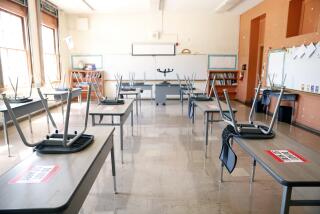Column: Did COVID complicate my 6th-grader’s first day of middle school? Not as much as you might think

- Share via
Is there any rite of passage more dreaded and anticipated than the first day of middle school?
And is there any middle-school tradition more fraught than the first locker?
Afghanistan has fallen to the Taliban, the Delta variant of the coronavirus is surging, but in our house, conversations between the 11-year-old and me have revolved around one thing: lockers.
In the weeks leading up to Monday, the first day of full-time public school since March 2020, I fielded dozens of questions on the theme:
Will I get my locker on the first day? How big are lockers? Will I be able to work the lock? How does a lock work, anyway?
Her obsession was slightly vexing to me — I am far more worried about her unvaccinated status — but I recognized that she was hanging her anxiety on this particular hook. So I tried to be patient as I answered her questions ... over and over.
When the first day of middle school finally arrived, we showed up at 7:45 a.m., plenty early (we thought) to meet up with friends from elementary school amid a sea of strangers. Our plans were foiled, however, by the hundreds of students and parents who were already standing in lines that spilled off the school grounds and down the sidewalks. At the top of the steps, school staff members were carefully checking in the children, one by one.
Some of us were lucky enough to have been able to print out the QR code that constitutes the Los Angeles Unified School District’s Daily Pass before the overwhelmed system crashed. Others had to answer the checklist of questions about symptoms and COVID exposure at the schoolhouse door, which slowed things considerably.
I was delighted to note that everyone — parents and children alike — wore masks.
I don’t know how it has been for other families, but my niece loves her mask. It makes her feel safe. We are puzzled by all the videos we’ve seen in which parents and public officials compare mask mandates to child abuse. Occasionally, I even have to remind my niece to take off her mask.
“Why?” she once asked. “Maybe I don’t want anyone to see my face.”
“Because you’re going surfing,” I replied.
After about 20 minutes in line, shortly after 8 a.m., she made it past the checkpoint and disappeared into the maw of her new school.
::
LAUSD’s mandate requiring teachers and staff to be vaccinated by Oct. 15 is a welcome development for those of us with children too young to receive inoculations.
The notion that receiving a vaccine is an entirely personal decision with only personal consequences is laughably at odds with the science.
Recently, I have found myself in discussions with vaccine-hesitant acquaintances who say they are waiting for final Food and Drug Administration approval before considering a jab.
But this is silly; the FDA gave emergency authorization to the three major new vaccines months ago because we were in a public health emergency — still are, in fact. Not only was the FDA satisfied that the vaccines were safe and efficacious, but as we have seen with the many millions of people who have been inoculated, the vaccines have proved to be safe and efficacious.
Do they work 100% of the time? No, but no one ever expected they would.
As of Aug. 9, according to the Centers for Disease Control, more than 166 million people in the United States have been fully vaccinated against COVID-19.
Of those, the agency says, reports from 49 states and territories indicate that 8,054 people suffered breakthrough infections that resulted in hospitalization or death. The CDC reports that 1,587 vaccinated people have died, though about 21% of the fatal cases were reported as asymptomatic for COVID or unrelated to the virus.
In any case, there is a vanishingly small chance that a vaccinated person will be even hospitalized with a breakthrough infection, let alone die from it.
However, the agency has continued to collect data about the vaccines while following its normal, if somewhat accelerated, protocol for approval.
Vaccines are expected to receive full approval, possibly by the end of this month or in September.
In June, CDC director Rochelle Walensky said that the vaccines are so effective that “nearly every death” due to COVID-19 is “entirely preventable.”
Waiting on full FDA approval is — I have to say it — selfish and irresponsible.
The moment that children under 12 are allowed to be vaccinated, my niece and I will be first in line.
::
My niece was breathless with excitement when I picked her up at 3 p.m.
“It was great!” she said.
She and her sixth-grade classmates had spent the entire day with their homeroom teacher, learning about the ways of middle school.
At lunch, she said, she’d met up with her elementary school friends. After part-time, in-person school resumed last year, they relished their status as the big kids on campus. Suddenly, they fretted, they were the little ones again.
When I asked her how it went with the locker, she shook her head and smiled.
“I’m supposed to get it tomorrow,” she said. “It’s no big deal.”
Later at home, I found a crumpled piece of paper with some of her handwritten notes from the first day:
“Keep your hands and legs and other body parts to yourself.”
“No horseplay.”
“Do not use bad language.”
“Respect others and yourself.”
Seems like excellent advice — and not just for middle-schoolers.
More to Read
A cure for the common opinion
Get thought-provoking perspectives with our weekly newsletter.
You may occasionally receive promotional content from the Los Angeles Times.











